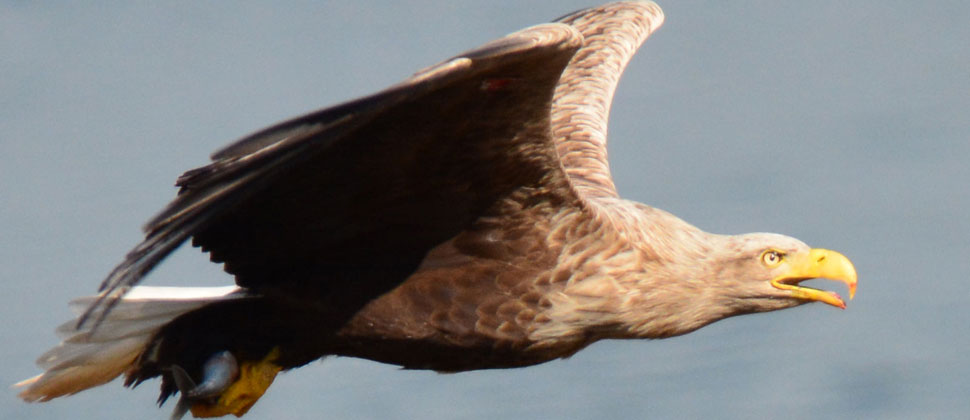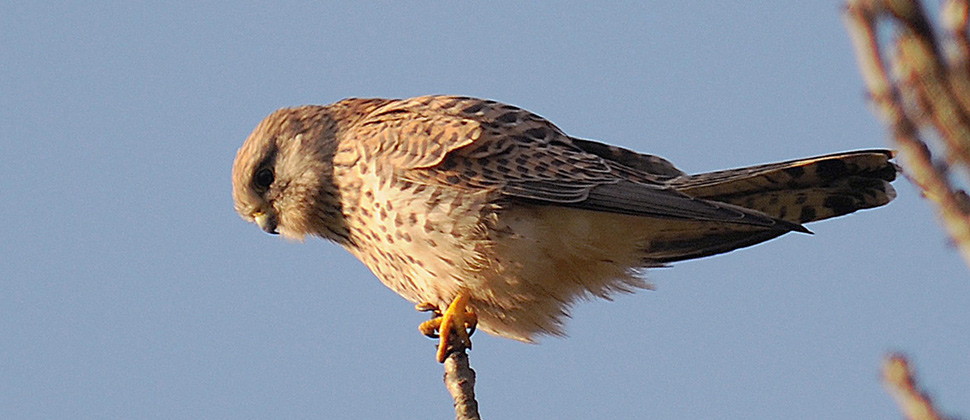News
: Feb 2014
25 February 2014
Brian Etheridge was awarded the 2014 Donald and Jeff Watson Raptor Award at the annual SRSG conference on Saturday. Here is the official citation:
Brian is a founding member of the Highland Raptor Study Group and is currently the Group’s secretary.
His interest in raptors developed at an early age where, under the guidance of Brian Little, he and his mates, including such future giants of the raptor world as Mick Marquiss and Eric Meek, were out hunting the nests of Merlin and owls around Newcastle.
His interest developed during his time in the RAF, both when stationed abroad studying the likes of migrating honey buzzards at Gibraltar and at home where he started his own studies of sparrowhawks and buzzards around Kinloss.
He started work for the RSPB in 1988 and, although he was paid for much of his raptor work, largely on hen harriers and red kites, he did a lot that was unpaid work. In fact he would have done it anyway, paid or not, and that is a mark of a true enthusiast.
Brian has worked on many species but is particularly knowledgeable about hen harriers, red kite, merlin, honey buzzard, buzzard and goshawk and he is always happy to pass on that knowledge to others and help them if needed.
And, tellingly, much of Brian’s fieldwork has been in areas of high persecution where he’s never shied away from the issue; he’s done as much as anyone to shine a light on persecution incidents and those who do raptors harm.
The Donald and Jeff Watson Raptor Award is given in recognition of a significant long-term amateur contribution to the study of raptors in Scotland. Congratulations to Brian for a thoroughly well-deserved award.
24 February 2014
The Scottish Raptor Study Group (SRSG) is very pleased to have been invited to give its views on the above petition, to formally declare the Golden Eagle, Aquila chrysaetos, as the national bird of Scotland. SRSG feels that there are compelling arguments for granting this petition so as to designate the Golden Eagle as Scotland’s national bird, for the reasons set out below.
Scotland’s Golden Eagle population, comprising some 440 pairs which occupy their own exclusive individual nesting territories, is important in terms of numbers in an overall European context. These Scottish Golden Eagle pairs are to be found at present largely in the Highlands of Scotland, but with a small part of the population located in the uplands of southern Scotland.
SRSG soon after its inception singled out the Golden Eagle as the most fitting species for its logo which is based on artwork by the renowned wildlife artist Keith Brockie, a skilled Golden Eagle fieldworker in his own right. There has been and still is a world-wide focus on Scottish Golden Eagles through the writings of distinguished Scots such as Seton Gordon who was an inspiration to Golden Eagle enthusiasts throughout much of the 20th century, Adam Watson whose Golden Eagle study is the longest-running one anywhere on the planet and the late Jeff Watson, author of the definitive monograph on the species.
The Golden Eagle is uniquely fitted to be designated as Scotland’s national bird through its perception in the minds of many as an iconic symbol of wildness, strength and survival. The perception as to survival is enhanced by the fact that the Golden Eagle managed to hold out in the Scottish Highlands when in the late 19th and early 20th centuries some other species were extirpated through man’s agency. It is known that many visitors to Scotland want to see three animals, namely the Loch Ness Monster, the Red Deer and the Golden Eagle. That in itself should give the charismatic Golden Eagle, an example of rugged power in the acclaimed Scottish landscape, pride of place as Scotland’s national bird.
SRSG feels that it is particularly appropriate, for the Scottish Parliament’s consideration of the petition, that last month the Scots Pine was officially named as Scotland’s national tree. The Golden Eagle and the Scots Pine can be said to complement each other through choice of the latter as the favourite nest tree of the Golden Eagle, to the extent that it is not a crag-nester. SRSG suggests that the argument for national status for the bird is boosted by what is now the national status of its host tree, the Scots Pine.
The Golden Eagle’s link with the Scots Pine should become still more apparent if the bird expands its numbers and breeds, as it should, in lowland habitats. There is no ecological reason why Golden Eagles in Scotland should remain birds of the hill country only. A valid comparison is with Sweden, for example, where there is a productive tree-nesting Golden Eagle population on low-lying agricultural land. Thus in Scotland lowland Scots Pine forests could hold breeding Golden Eagles, banished at present to the hill country through past, and unfortunately in many places still continuing, criminal persecution.
SRSG contends that designation of the Golden Eagle as Scotland’s national bird would help to reduce the impact of such persecution, through increased interest in conservation of the species and removal (or at least reduction) of the factors operating against it. It is clear that many more people, both residents in and visitors to Scotland, would like to be able to see Golden Eagles than are able to at present. Designation should help towards this end. The resulting increased interest in the Golden Eagle would be to the benefit of environmental education, wildlife tourism and thus local economies.
18 February 2014
The Scottish Raptor Monitoring Scheme (SRMS) is seeking a dynamic, self-motivated person with raptor ecology, survey and monitoring experience to coordinate the work of the Scheme. The post will be hosted by BTO Scotland, on behalf of the SRMS. Two-year fixed-term contract. Salary: £21,452 – £23,835 pa + pension. Job share considered. Closing date: 18th March 2014. For further detailed information and how to apply please see here.
16 February 2014
George Macdonald, the Training, Education and Development Officer of the Scottish Gamekeepers’ Association has come under fire for seeming to back a call for the ‘complete eradication’ of pine martens and sea eagles. The full story can be read here.
12 February 2014
Channel 4 News featured a report this evening about the illegal persecution of raptors on Scottish grouse moors. The report included interviews with SRSG member Logan Steele, RSPB Scotland’s Head of Investigations Ian Thomson, and Scottish Gamekeepers’ Association Chairman Alex Hogg. Astonishingly, Alex Hogg denied that gamekeepers were involved with the poisoning, shooting and trapping of raptors. It’s hard to fathom why he would tell such a blatant lie when there is ample evidence that destroys his claim. Indeed, the SGA recently confirmed that three of their members were expelled following their convictions for raptor persecution (see here). Mr Hogg’s disappointing attitude undermines the credibility of the PAW Scotland Raptor Group, a committee on which both the SRSG and the SGA serve, with the purported objective of clamping down on those who commit illegal raptor persecution offences. Mr Hogg also put forward a proposal for raptor culling on grouse moors ‘when raptors become a problem’. For further information on the news report see here and here.
11 February 2014
A letter published by the Scottish Farmer this week is a good example of the Victorian attitude toward raptors that still persists in some areas of Scotland. The letter was written by a former Crofting Commissioner and betrays an astonishing level of ignorance and prejudice. Members of the Scottish Raptor Study Group work closely with many enlightened crofters and hill farmers and thankfully, this particular crofter’s view is not shared by the majority but it’s still an indicator of how much work there is to do.
SIR, – Listening to and reading about the Winter Watch tv programme regarding sea eagles, I found most of it incredible and so ‘too bad’ as far as the loss of lambs was concerned – they didn’t even mention hoggs or ewes.
Then, for Mr Warnock of NFUS to say: “Sea eagles are here to stay”. Surely it’s time for him to vacate his perch – and if that is the view of the NFUS, what a precarious position hill sheep farmers and crofters are in.
Nothing short of complete eradication will do, and it is the same for the pine martin – both should be absolutely destroyed. The National Sheep Association, the Crofting Commission and Crofting Federation should be backing this to the hilt.
Will Mr Lochhead or Mr Wheelhouse do anything about the sea eagle? No, they didn’t even prick their ears until a danger to our native eagle was mentioned and, for Mr Lochhead to say they are a tremendous tourist attraction is rubbish. If, like me, he had spoken to tourists from all over the world over the last 20 years at ‘Working Sheepdogs’ here, he would know they don’t come for one attraction but to see as much as they possibly can. The oblivion of the sea eagle wouldn’t matter and, indeed, would be an absolute blessing for the countryside and its animals.
DW Ross,
Leault,
Kincraig
2 February 2014
The Scottish Ornithologists’ Club has become the latest organisation to call for game-shooting regulation in Scotland following the latest reported raptor persecution crimes. The SOC has written to the Environment Minister to condemn the on-going acts of raptor persecution associated with driven-grouse moor management, and to urge him to “give serious consideration to the introduction of measures that will impose a degree of regulation of the game shooting industry in Scotland, with the possibility of revocation of sporting rights where there is a clear breach of the law“. Their letter can be read here.
Archive:
2015
- February,
- January,
2014
- December,
- November,
- October,
- July,
- June,
- May,
- April,
- March,
- February,
- January,
2013
- December,
- November,
- October,
- September,
- August,
- July,
- June,
- May,
- January,
2012
- December,
- November,
- October,
- September,
- August,
- July,
- June,
- May,
- April,
- March,
- February,
- January,





